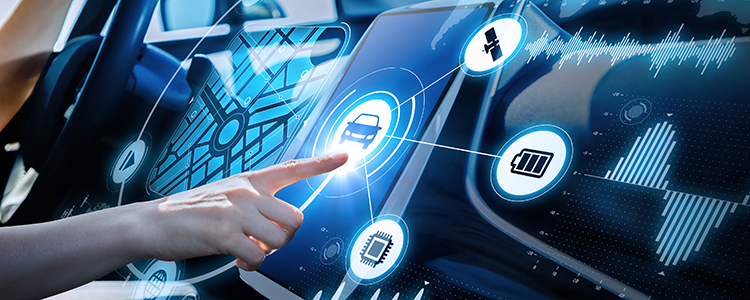
Vehicle telematics and communications tax: What's next for the consumer auto industry?
If there's one trend that holds big promise for the automotive industry, it's telematics. Expected to approach $99 billion within the next six years, this market opens the door to all kinds of advanced offerings — from vehicle security and roadside assistance to conciergelike luxury services.
Driven by consumer demand as well as the role big data plays in industry research and product development, the rapid pace of growth means it’s a critical time for automakers and telematics service providers to ensure they’re keeping pace with potential communications taxation implications.
What exactly is automotive telematics?
Automotive, or vehicle, telematics is exactly what it sounds like: a combination of communications and information services. Within the automotive industry, telematics allows manufacturers to use in-vehicle equipment such as event data recorders, communication systems, navigation devices, and GPS to provide a wide range of information and services.
First popularized by General Motors subsidiary OnStar Corporation, built-in automotive telematics has been a part of the passenger automotive industry since the 1990s. However, it's the recent surge in activity — driven, in part, by advancements in data collection and wireless network technology — that's creating a real sea change.
This is due, to some extent, to the fact that cellular data is at the foundation of automotive telematics. By relying on a cellular network to securely (and with permission) gather data related to vehicle usage, providers can offer a wide array of services. While these services may also include a voice component, they do not utilize the public switch network.
What kinds of telematic services can consumers access?
From safety and emergency response to travel and parking assistance — plus many other areas — the range of services offered to drivers of passenger vehicles is far-reaching. And new innovations are being introduced all the time. Just a few examples include:
- Automatic accident response to have help sent instantly in the event of a vehicle crash
- Vehicle theft services to alert owners when a car alarm goes off or a door is left open, or to help track a stolen vehicle and even prevent a thief from restarting the engine
- Detailed turn-by-turn navigation that includes automatic downloads of new roadway changes and one-on-one assistance
- Remote access to start, lock, unlock, and close windows, or to locate and track a personal vehicle — be it to warm it up in winter, make due with lost keys, or keep an eye on teen driving activities
- On-board diagnostics to monitor the performance of a car's major components and alert owners to potential problems or servicing needs
Vehicle telematics is also used to provide personal roadside assistance, keep tabs on parking locations, alert drivers to dangerous weather and road conditions, provide concierge-style ordering and reservation services, and even to deliver ecommerce orders to trunks via drones.
And that's just for the consumer sector. In the world of fleet management, vehicle telematics gets even more comprehensive with a seemingly never-ending array of operational, diagnostic, and tracking services to increase business productivity.
The consumer applications for automotive telematics are virtually limitless, and continue to expand along with technology advancements. And while this is an exciting area of high-growth potential, there's a much more immediate concern that should first be addressed: taxation.
The complexity of telematics taxation
Automotive telematics is growing at a rate that’s far outpacing state tax guidance. That means manufacturers and telematics service providers alike must proceed with caution to minimize potential communications taxation risks in an exceedingly complex industry.
As new innovations and offerings are rolled out, tax complexities will continue to increase. In this uncertain landscape, even one seemingly small oversight can lead to costly liabilities. This industry sells at large scale, and a massive tax penalty or class action lawsuit are both real possibilities. From resale certificates to consumer-facing verbiage used to describe offerings, there are many areas where a company could inadvertently open itself up to a complicated web of communications taxes and regulatory fees.
To future-proof automotive telematics services, there are a few critical things every provider should do:
- Steer clear of bundling. This is one of the most important steps automotive companies should take from a transaction tax liability standpoint. Always keep telematics services, which are largely viewed as information services, separate from communications services, which are subject to communications taxation.
That means avoiding bundles that place hands-free calling or prepaid phone services using the public switch network alongside automotive telematics, as well as any sort of offer based on the use of both types of services. Doing so could render the entire bundle subject to a variety of transaction taxes and regulatory fees, and the difference can be significant. While sales tax typically falls within the realm of 6–7 percent, communications tax can reach as high as 18 percent.
- Market with caution. During my time as a tax director in the automotive industry, we had one important procedure: All marketing materials were required to go through the tax department. From web content and brochures to email marketing and advertising, the language used by your marketing team can play a big role in whether or not a service will be deemed liable for communications taxes.
While automotive pure telematics do not travel over the public switch network — services typically involve direct communication between the call center and the vehicle — hands-free calling services utilizing a third-party wireless carrier or prepaid service do. The tax treatments of each type of service are very different and should be treated as two different offerings in consumer-facing materials. By developing a relationship with the marketing team, tax teams can help ensure external communications don't erroneously offer phone services at times when only telematics services should be presented.
- Stay up to date. As jurisdictions continue to revisit their approaches to telematics taxation, it's critical to continually monitor state-by-state activities. With the fast pace of constant innovations, tax law changes and rulings can occur at any time. At a minimum, every automotive and telematics company should have dedicated personnel or a vendor to keep track of the latest updates.
Automotive telematics technology is advancing rapidly, ensuring communications taxation will continue to add complexities for providers. To remain competitive, it's imperative to stay aware of potential tax implications with each new offering or bundle.
Did you know? Avalara for Communications specializes in helping companies stay updated on the latest communications tax complexities. Learn more at avalara.com.












